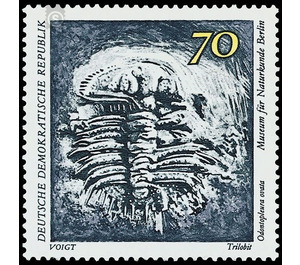Paleontological collections from the Museum of Natural History in Berlin - Germany / German Democratic Republic 1973 - 70 Pfennig
Theme: Architecture
| Country | Germany / German Democratic Republic |
| Issue Date | 1973 |
| Face Value | 70.00 |
| Color | black blue |
| Perforation | K 13 |
| Printing Type | Photogravure |
| Stamp Type | Postage stamp |
| Item Type | Stamp |
| Chronological Issue Number | 1569 |
| Chronological Chapter | GER-DDR |
| SID | 970402 |
| In 16 Wishlists | |
Paleontological collections from the Museum of Natural History in Berlin The Ministry of Posts and Telecommunications of the German Democratic Republic publishes six multicolored special postage stamps depicting motifs of paleontological collections from the Museum of Natural History in Berlin. Paleontological collections from the Museum of Natural History Berlin The fossils from the paleontological collections of the Museum of Natural History Berlin on the special stamps are particularly valuable original witnesses of the history of life on earth. They are both research objects and simultaneously used illustrative material in the educational work of the museum. The Museum of Natural History Berlin - an institution of the Humboldt University - preserves, maintains and extends, among other natural history collections, the largest paleontological collection of the GDR with about 15 million objects. 70 Pfennig Value: Trilobite, Odontopleura ovata EMMRICH Trilobites are an extinct class of the animal strain of Arthroooden (arthropods). They lived exclusively in the sea about 240 million years ago. Most trilobites were soil dwellers, others lived planktonic. In the Scandinavian rocks of the European Pleistocene glaciation area, which are deposited as sediment, trilobes are frequent finds and important guiding fossils. Due to their sometimes bizarre, sensitive shape they are usually only partially preserved. The illustration shows the holotype of the genus and species described in 1839. More recent and better prepared finds have more fully transmitted the spines of this species and other species.


